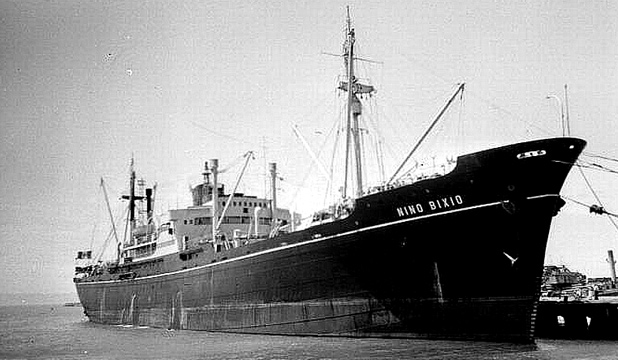
The "Nino Bixio".
Larger image.
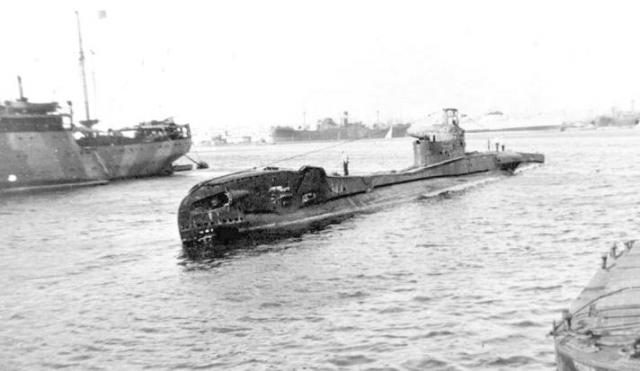
HMS "Turbulent".
Larger image.

Lt. Cdr. 'Tubby' Linton VC.
Larger image.
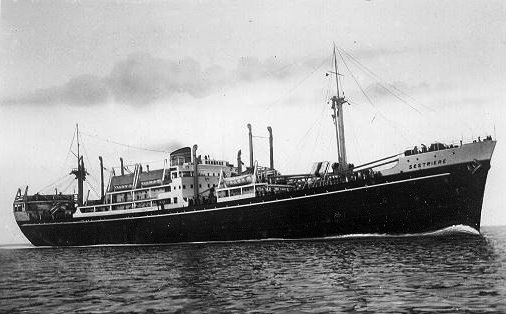
The "Sestriere".
Larger image.
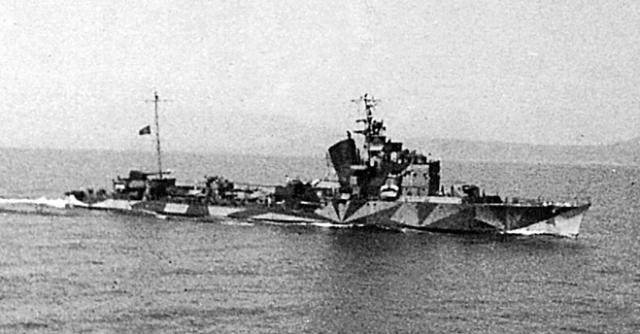
The "Saetta".
Larger image.
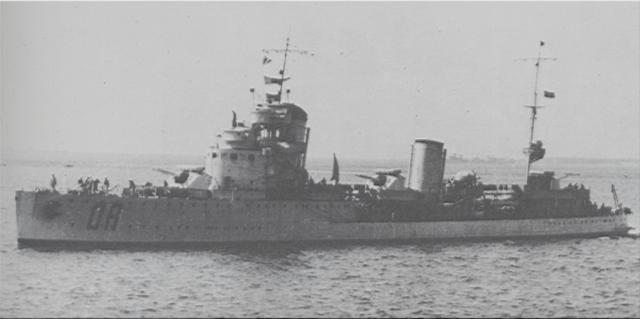
The "Da Recco".
Larger image.
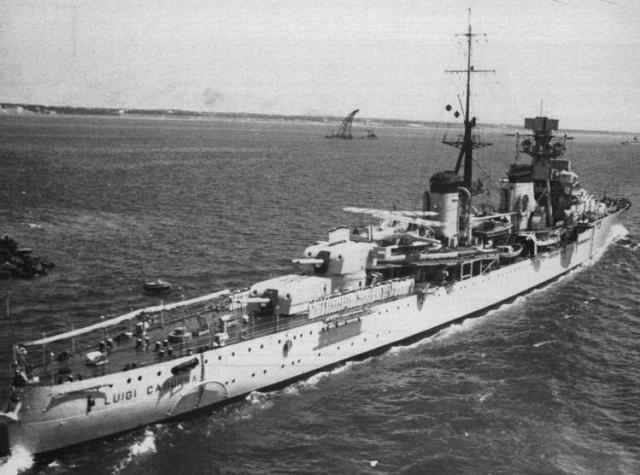
The "Luigi Cardona".
Larger image.
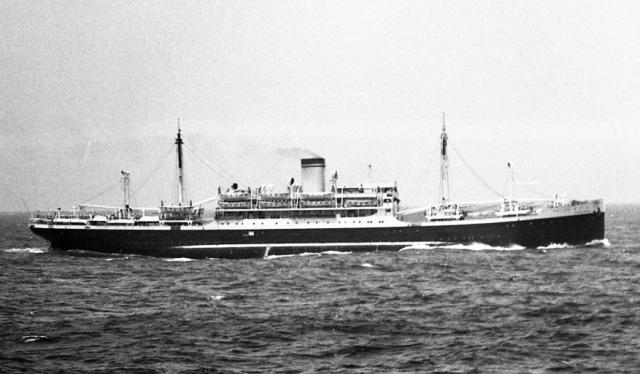
Post-war photo of the "Toscana", then a hospital ship.
Larger image.
To
those newly-minted Anzac POW moved from the El Alamein battlefields,
behind Axis lines, to the stench and squalor of the twin Italian transit
camps at Benghazi, the announcement that they were to board two ships
at anchor in the harbour to be taken to “la bella Italia” was received with mixed feeling. Movement across the Mediterranean would seal their chances of escape back to their Units at the front, but any escape from their present hell-hole to a Geneva-supervised prison camp would be a plus. The more optimistic even thought there would be a chance of interception by the British Navy. This turned out prophetic, but not in the manner intended.
The Allied strategic plan was to interrupt Rommel’s supply lines. Since “Ultra” had cracked the Axis battle codes, Allied navies knew the movements of enemy vessels. Standing orders for Allied submarines were to sink any Axis ship sighted, irrespective of cargo the ships might be carrying. While ships never gave any outward sign of carrying a human cargo of POW, the fact was well known to both sides. While this strategy was largely successful, with a lack of supplies being a major factor in Rommel's demise, it came at a cost.
On Sunday, August 16, 1942, some 4,500 Allied POW were loaded on to the "Sestriere" (POW last names A - M) and "Nino Bixio" (last names N-Z). The two-ship convoy left Benghazi bound for Brindisi in Italy, escorted by the Italian destroyers "Saetta" and "Da Rocca", plus two motor-torpedo boats - "Castore" and "Orione".
At 3:17 in the afternoon the following day, Monday August 17, 1942, the British submarine "Turbulent" commanded by Welsh-born Lt Cdr John 'Tubby' Linton (VC, DSO, DSC) had plotted its courseto intercept the convoy and seized its opportunity. It took bearings and fired four torpedoes in an attempt to knock out both merchant ships, despite their strong naval protection. "Turbulent" immediately submerged, successfully escaping a depth-charge counter attack.
The "Nino Bixio" suffered direct hits to Hold No. 1 containing Anzac, South African and British POW and to the engine room, disabling both the vessel's propulsion and power supples. A third torpedo grazed the rudder without expolding but did enough damage to cripple the ship's steering. The fourth torpedo had gyro problems and started circling, posing a danger to its source but ultimately caused no damage. The "Sestriere" sailed on unharmed under escort of "Da Recco".
The "Nino Bixio", altdhough settling in the water, didn't sink, although many jumped overboard in anticipation she would. She was taken in tow by "Saetta" and was beached early the following morning off the naval port of Navarino in Greece.
The escorting motor-torpedo boats, later assisted by the Italian cruiser "Luigi Cadorna" which had rushed to the scene, made the search for survivors. The hospital ship "Cordona" had also arrived to receive the wounded.
The casualty list from Hold No. 1 was 116 New Zealanders, 41 Australians, 16 British and 11 South African, more than one-third of all POW in the hold and over half of the 309 Anzacs. It is believed 7 Free French POW in Hold No. 2 were killed but there is no available figure for Indian POW in Hold No. 3 - the three holds forward of the engine room.
The near-new "Nino Bixio" was later towed to Venice and used as a block ship to seal the harbour entrance. In a twist of fate, she was raised and refitted in 1952 and in 1955 made a trip to New Zealand to several ports, including Wellington.
On the afternoon of January 25, 1955, a wreath-laying service of remembrance was held on the ship's foredeck to honour those that died - 13 years after the event.
This is an account of the torpedoing by a New Zealand survivor, Pte Charles Watkins, 25 Bn, who was as far away from the entry point of the torpedo as it was possible to get, half way up the walls of the hold on a catwalk than ran around the bulkhead.
"I was playing bridge with another Kiwi and two Australians. I'd taken six tricks, but I couldn't see how I was going to take the others. The torpedo then burst into the hold, ending the game.
"It was no laughing matter I can tell you. There was a lot of swearing and yelling and jumping around. We were in humid semi-darkness. The explosion had wrecked the two wooden ladders to the bottom half of the hold now submerged in the surging sea. When the rescue started, we pulled up some of the injured with ropes and others on a bit of a stretcher made from the remains of one of the wooden ladders. But it was a hopeless task. Nothing could be done for those screaming for help in the water. You had to walk over dead bodies to move anywhere.
“The two ladders leading from the catwalk to the deck were still intact and slowly those in the upper part of the hold managed to get to the deck. Some jumped overboard, but it was now obvious that the bulkhead had held and the "Nino Bixio" was not going to sink.
“Medical facilities were minimal, but some sort of order began to emerge, but it was too late to save many of the wounded.
“The "Sestriere" had sailed out of sight and one of the escort boats was busy running a towline to the "Nino Bixio". Somehow the night passed and next morning we found ourselves beached and help was arriving from land.
“The process of unloading wounded began, but most of the casualties had gone into the sea. We were among the last to be taken off the ship.”
This is an account of the event by an Australian survivor of hold No. 1, Bill Rudd, 2/7 RAE.
"All I can remember after embarkation into the forward hold was finding, on the steel mezzanine deck that ran around the hold, a space between a South African sergeant and a Kiwi private. It was incredibly hot and stuffy and the rhythmic beat of the engines and the slow roll of the ship made dozing almost a permanent state of mind and the time of night or day of little consequence.
"I remember a sudden tremendous thud and the "whoompf" of the torpedo bursting into the hold. The ship slowed immediately and I learned later that another torpedo had struck the engine room amidships. Looking down on the bottom of the hold was like watching a surreal merry-go-round. It was still daylight and the clear white and jade-green water was swirling around in a clockwise direction with bodies, clothing, petrol drums that had served as urinals and all sorts of gear revolving at a mad pace.
"The water was also rising rapidly and the smell of cordite hung thickly in the foetid air. Men were pressing towards the ladder leading upwards to the deck and the human tide carried me with it. Somehow it carried me also to the deck and the sight of the open sky and the fresh smell of the sea was unbelievably welcome.
"On deck it was a scene of complete confusion. Those on the deck immediately above the hold, mainly guards, had been blown to bits. There were remains of humans hanging in the rigging and body parts littered the bloody deck. An anti-aircraft gun was a mangled twisted piece of steel, crushed under steel deck beams which had been hurled upwards by the force of the explosion and then crashed back onto the ship. POW were pouring up from other holds and many, mainly Indians, were jumping off the decks into the sea. The red-bearded Captain of the ship [Antonio Raggio], with revolver in hand, was shouting orders and trying to restore some semblance of sanity and discipline among his crew.
"The "Nino Bixio" was settling lower into the water but did not appear to be sinking and ropes appeared from somewhere and those that had reached the open deck were hauling badly injured mates and bodies out of the watery hell of Number 1 hold.
"One of the escorting Italian destroyers that had been circling the "Nino Bixio" dropping depth charges through the carpet of bobbing heads of those that had leapt overboard, broke off to attach a cable to her as daylight began to fade and begun the slow haul toward the land that could be seen to starboard.
"It was a long night, but by daylight the "Nino Bixio" had been beached off Novarino Harbour in Greece and rescue teams of both Germans and Italians came aboard to supervise the evacuation of the ship. Unwounded New Zealanders and Australians were left to the last and were put to work cleaning up the ship, reeking with the smell of death. Finally, they too, were ferried ashore.”

A wreath-laying service on the "Nino Bixio" foredeck, Wellington harbour, January 25, 1955.
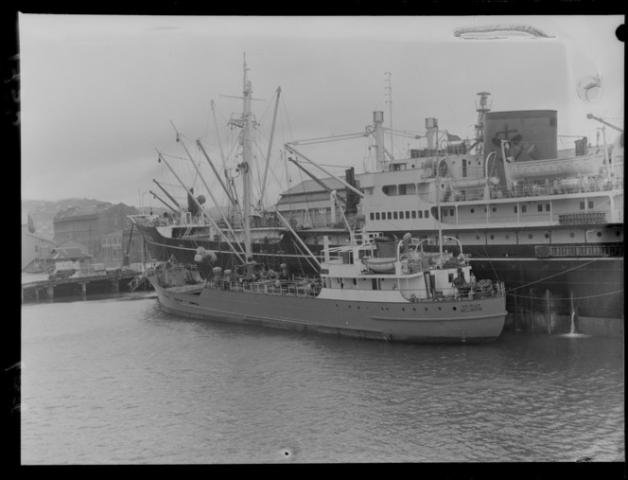
"Nino Bixio" docked at Wellington harbour, January 25, 1955.

New Zealand survivors on board the "Nino Bixio", Wellington harbour, January 25, 1955.
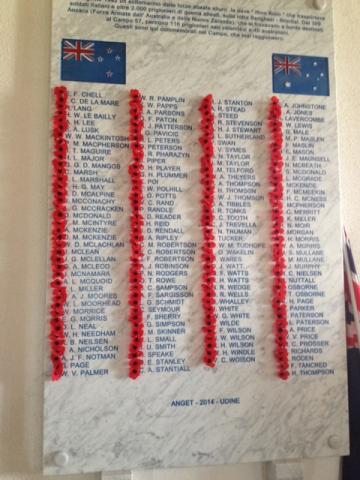
The memorial to the 155 Anzac casualties on the "Nino Bixio" displayed within La Chiesetta at the site of Campo 57, 2014.
The "Nino Bixio"